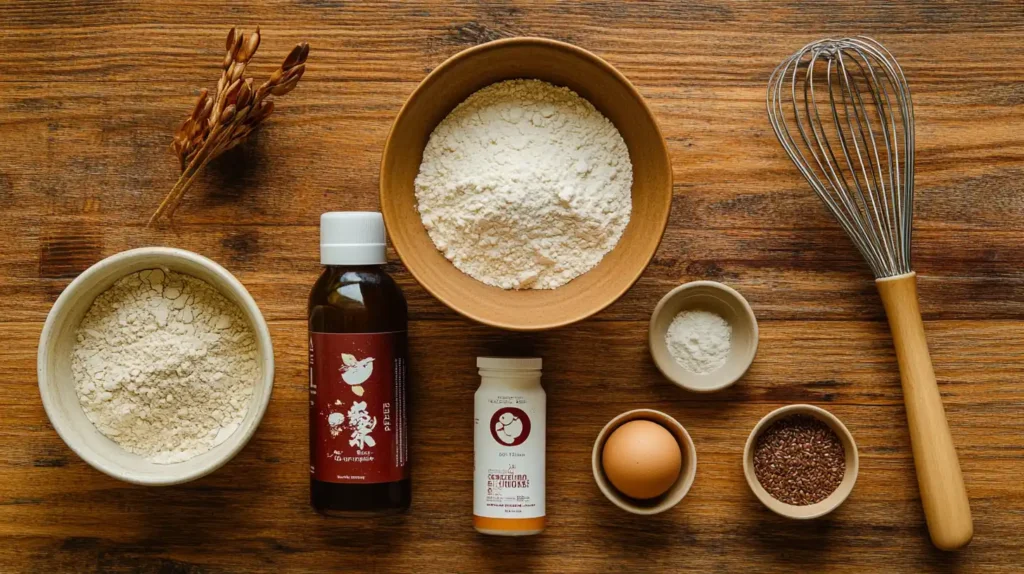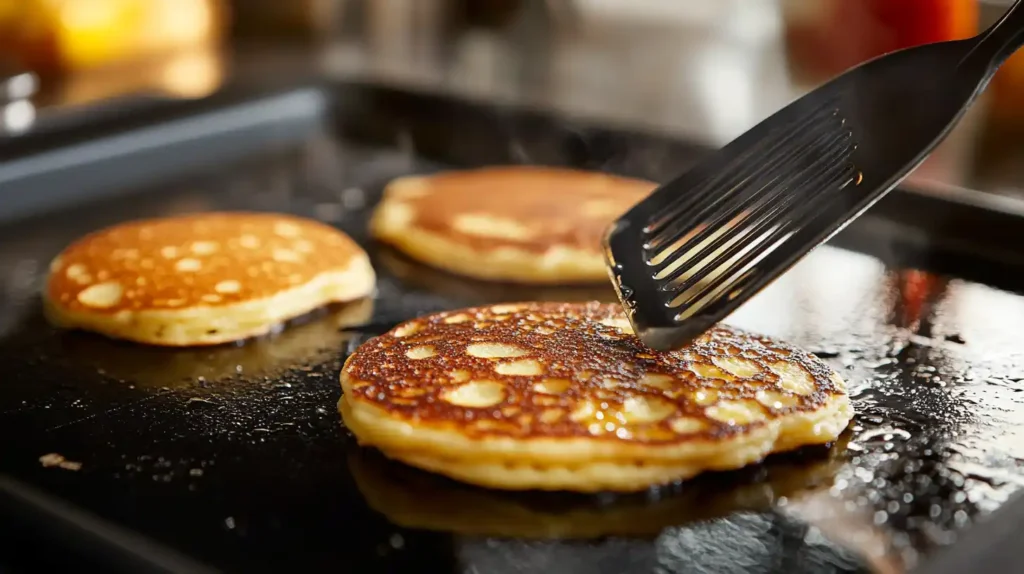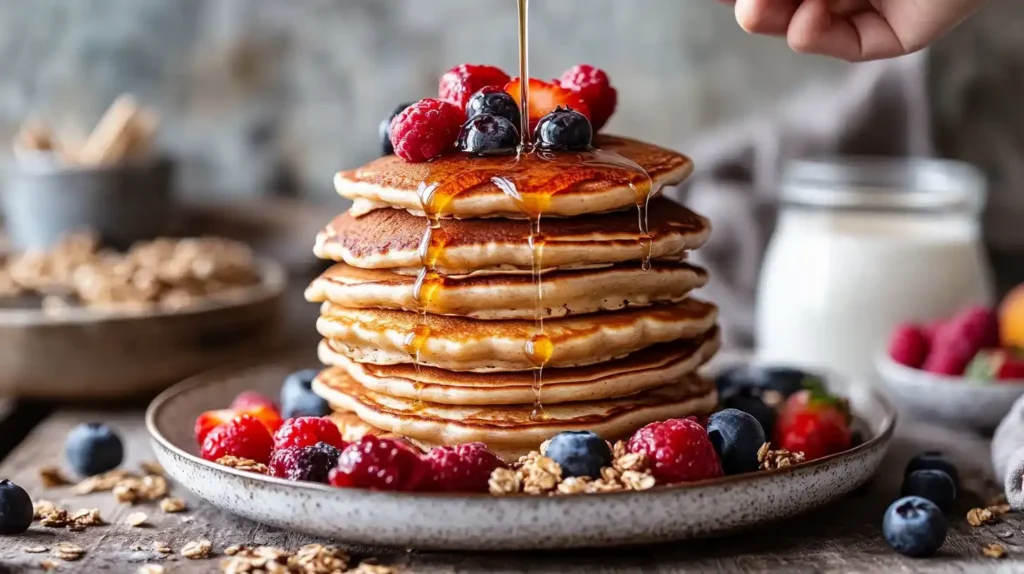Table of Contents
Why Choose a Milk-Free Pancake?
Milk-free pancakes offer a delicious solution for individuals with dietary restrictions or health concerns. Whether you are lactose intolerant, vegan, or simply exploring alternatives to traditional recipes, milk-free pancakes can be a great option. Choosing milk substitutes can also provide unique flavors and nutritional benefits, catering to a variety of tastes and dietary needs.
- Health Reasons: Many people avoid milk due to lactose intolerance, allergies, or personal health goals. Milk-free pancakes eliminate these concerns, ensuring a safe and enjoyable meal for everyone.
- Dietary Restrictions: For vegans or those on plant-based diets, milk-free pancakes align with their lifestyle while maintaining the fluffy and delicious qualities of classic pancakes.
Essential Ingredients for Pancake Without Milk
Crafting perfect milk-free pancakes starts with understanding the key components and choosing the right substitutes. A good recipe balances taste, texture, and nutritional value.
- Substitutes for Milk: Common alternatives include plant-based milks like almond milk, soy milk, oat milk, or coconut milk. Water or juice can also work in a pinch. These substitutes not only replace milk but can also enhance the flavor profile of the pancakes.
- Key Components of Pancakes: Alongside the milk substitute, essential ingredients include flour, a leavening agent like baking powder, a sweetener, eggs or an egg substitute for binding, and a fat source such as oil or butter. These ingredients work together to create the fluffy, golden-brown pancakes you love.

Tools You’ll Need
Making milk-free pancakes is simple and enjoyable, especially when you have the right tools at hand. Proper equipment ensures your cooking process is smooth, efficient, and mess-free.
- Cooking Utensils: A mixing bowl, whisk, and spatula are essential for preparing and flipping the pancake batter. Non-stick pans or griddles are recommended for even cooking and easy flipping without sticking. A ladle or scoop can help pour the batter into uniform sizes.
- Measuring Tools: Accurate measurements are crucial for achieving the perfect consistency in your pancake batter. Keep measuring cups for dry and liquid ingredients and measuring spoons handy for smaller quantities like baking powder or sweeteners.
Step-by-Step Recipe
Creating milk-free pancakes is a straightforward process that ensures delicious results every time. Follow these steps to achieve perfectly fluffy and golden pancakes.
Preparing the Batter
- Choosing the Right Consistency: Start by gathering your ingredients, including a milk substitute (e.g., almond milk, soy milk, or oat milk), flour, baking powder, a sweetener, eggs (or an egg substitute), and oil or butter.
- In a mixing bowl, combine the dry ingredients: flour, baking powder, and a pinch of salt.
- In another bowl, whisk together the wet ingredients: your chosen milk substitute, eggs, and oil.
- Gradually mix the wet ingredients into the dry ingredients. Stir gently to avoid overmixing, aiming for a slightly lumpy batter. This consistency helps create airy pancakes.
Cooking Perfect Pancakes
- Heat Settings: Preheat a non-stick pan or griddle over medium heat. Lightly grease the surface with oil or butter to prevent sticking and ensure even cooking.
- Timing: Use a ladle or scoop to pour batter onto the pan, forming pancakes of your desired size. Cook for 2-3 minutes, or until bubbles form on the surface and the edges start to set. Flip the pancake gently using a spatula, then cook the other side
- for another 1-2 minutes until golden brown.

Tips for Fluffy Pancakes Without Milk
Achieving fluffy pancakes without milk is all about understanding the right ingredient combinations and avoiding common pitfalls. Here are some tips to perfect your milk-free pancakes:
- Ingredient Combinations:
- Use a plant-based milk alternative with a rich texture, like oat or soy milk, to mimic the creaminess of regular milk.
- Incorporate baking powder or baking soda as a leavening agent to ensure the pancakes rise well. Adding a splash of lemon juice or vinegar to the batter can activate these agents for extra fluffiness.
- Use eggs or an effective egg substitute, such as flaxseed meal mixed with water, for binding and structure.
- Avoiding Common Mistakes:
- Do not overmix the batter; it’s okay if it’s slightly lumpy. Overmixing can result in dense pancakes.
- Make sure your griddle or pan is at the right temperature—medium heat works best. A too-hot surface can burn the outside while leaving the inside undercooked.
- Avoid overcrowding the pan; cook pancakes one or two at a time for better control.
Variations of Milk-Free Pancakes
Milk-free pancakes can be adapted to meet a variety of dietary preferences or to explore new flavors. Here are two popular variations:
- Vegan Pancakes:
- Replace eggs with flaxseed meal or chia seeds mixed with water (1 tablespoon of seeds + 2.5 tablespoons of water for each egg).
- Use plant-based milk like almond, oat, or coconut milk.
- Sweeten with maple syrup, agave nectar, or coconut sugar for a completely plant-based option.
- Gluten-Free Options:
- Substitute all-purpose flour with a gluten-free blend, almond flour, or oat flour.
- Add xanthan gum if your gluten-free flour doesn’t already contain it, as it helps bind the batter.
- Double-check that your baking powder and other ingredients are labeled gluten-free.
Topping Ideas for Milk-Free Pancakes
Elevate your milk-free pancakes with a variety of sweet and savory toppings to suit your taste:
- Sweet:
- Fresh fruits like berries, bananas, or sliced apples add natural sweetness and a burst of flavor.
- Drizzle with maple syrup, honey, or agave nectar for classic sweetness.
- Add a sprinkle of powdered sugar, cinnamon, or cocoa powder for a touch of elegance.
- Try nut butter, coconut cream, or dairy-free yogurt for a creamy complement.
- For indulgence, use dairy-free chocolate chips, caramel sauce, or a handful of granola.
- Savory:
- Top with avocado slices, a sprinkle of sea salt, and a dash of lemon juice for a fresh and creamy option.
- Add sautéed mushrooms, spinach, or cherry tomatoes for a veggie-packed twist.
- Pair with vegan cheese or plant-based sausage for a hearty breakfast.
- Try a drizzle of hot sauce or a dollop of hummus for a bold flavor profile.

Nutritional Benefits of Milk-Free Pancakes
Milk-free pancakes can be a healthier alternative depending on your ingredient choices, offering several nutritional advantages:
- Caloric Content:
- Substituting milk with plant-based alternatives like almond or oat milk can reduce calories and fat content.
- Opting for whole-grain or gluten-free flours adds fiber and nutrients, making the pancakes more filling and wholesome.
- Health Advantages:
- Suitable for lactose-intolerant individuals or those with dairy allergies, ensuring a worry-free meal.
- Plant-based milk options often contain added vitamins like calcium, B12, and vitamin D.
- Customizing ingredients, such as using natural sweeteners or reducing oil, allows for a heart-healthier breakfast option.
- Vegan or gluten-free variations cater to specialized diets while maintaining essential nutrients.
Common Mistakes to Avoid
When making milk-free pancakes, it’s important to steer clear of common errors that can affect their taste and texture. Here are two key pitfalls to avoid:
- Overmixing:
- Stirring the batter too much can develop the gluten in the flour, resulting in dense, chewy pancakes instead of light and fluffy ones.
- Mix the wet and dry ingredients gently until just combined, even if there are small lumps in the batter—these will smooth out during cooking.
- Incorrect Measurements:
- Precision is crucial in pancake-making. Using too much flour can make the batter too thick, while too little can result in flat, lifeless pancakes.
- Use proper measuring cups for dry and liquid ingredients, and level off the flour with a knife for accurate results. Follow the recipe proportions to achieve the perfect balance of wet and dry ingredients.
Frequently Asked Questions
Can you use water instead of milk for pancakes?
Yes, you can use water instead of milk in pancake recipes. While water won’t provide the same richness as milk, you can enhance the flavor by adding a touch of vanilla extract, a pinch of sugar, or using sparkling water for a lighter texture.
What can I use instead of milk in pancakes?
There are several alternatives to milk in pancakes, such as plant-based options like almond milk, soy milk, oat milk, or coconut milk. Juice, water, or even yogurt (diluted slightly) can also work, depending on the flavor and texture you desire.
Can I use water in Bisquick instead of milk?
Yes, water can be used instead of milk with Bisquick, but the pancakes may be less rich and flavorful. To enhance the texture and taste, consider adding a bit of melted butter or a plant-based milk alternative.
What makes pancakes fluffier?
Fluffier pancakes are achieved by:
Using a leavening agent like baking powder or baking soda.
Avoiding overmixing the batter to retain air bubbles.
Cooking the pancakes on medium heat, which allows them to rise evenly.
Letting the batter rest for a few minutes before cooking to activate the leavening agents.
Storage Tips for Pancakes
Refrigeration
Store leftover pancakes in an airtight container in the refrigerator for up to 3 days. To reheat, use a microwave, toaster, or skillet over low heat for a quick warm-up.
Freezing
For longer storage, freeze pancakes by placing a sheet of wax paper between each one to prevent sticking. Store them in a freezer-safe bag or container for up to 2 months. To reheat, pop them in a toaster or heat them in the oven at 350°F (175°C) until warmed through.
Alternative Recipes for Special Diets
Keto Pancakes
Keto pancakes are low in carbs and high in healthy fats, perfect for those following a ketogenic diet.
- Ingredients: Almond flour or coconut flour, eggs, unsweetened almond milk, baking powder, and a low-carb sweetener like erythritol.
- Preparation: Mix the ingredients to form a batter, cook on medium heat, and top with sugar-free syrup or fresh berries. The result is a fluffy, satisfying pancake without the carbs from traditional flour.
Paleo Pancakes
Paleo pancakes align with the principles of the Paleo diet, avoiding grains and dairy.
- Ingredients: Almond or cassava flour, eggs, unsweetened coconut milk, mashed banana or applesauce (as a natural sweetener), and a pinch of cinnamon.
- Preparation: Combine the ingredients into a smooth batter, cook in a greased skillet, and serve with honey or fresh fruit for a wholesome breakfast.
History of Pancakes Without Milk
Origins
Pancakes without milk have likely been made for centuries, originating from cultures where milk was scarce or avoided for religious, economic, or practical reasons. Traditional recipes often used water, juice, or fermented liquids as substitutes for milk, resulting in diverse pancake styles across the world.
Cultural Significance
- European Influence: In many European countries, variations of milk-free pancakes were staples in lean times or during religious fasting periods, such as Lent.
- Asian Inspiration: In Asian cuisine, milk is less commonly used in traditional batter recipes, with water or rice-based liquids serving as alternatives.
- Modern Adaptations: Today, milk-free pancakes cater to dietary needs, such as lactose intolerance, veganism, and health-conscious eating. These recipes celebrate the versatility and inclusivity of this beloved breakfast item.
For those looking for other dairy-free options, the Pancakes Recipe Without Eggs offers another creative solution to dietary restrictions. Whether you’re searching for breakfast classics or innovative takes, these recipes are perfect for complementing your culinary adventures.

